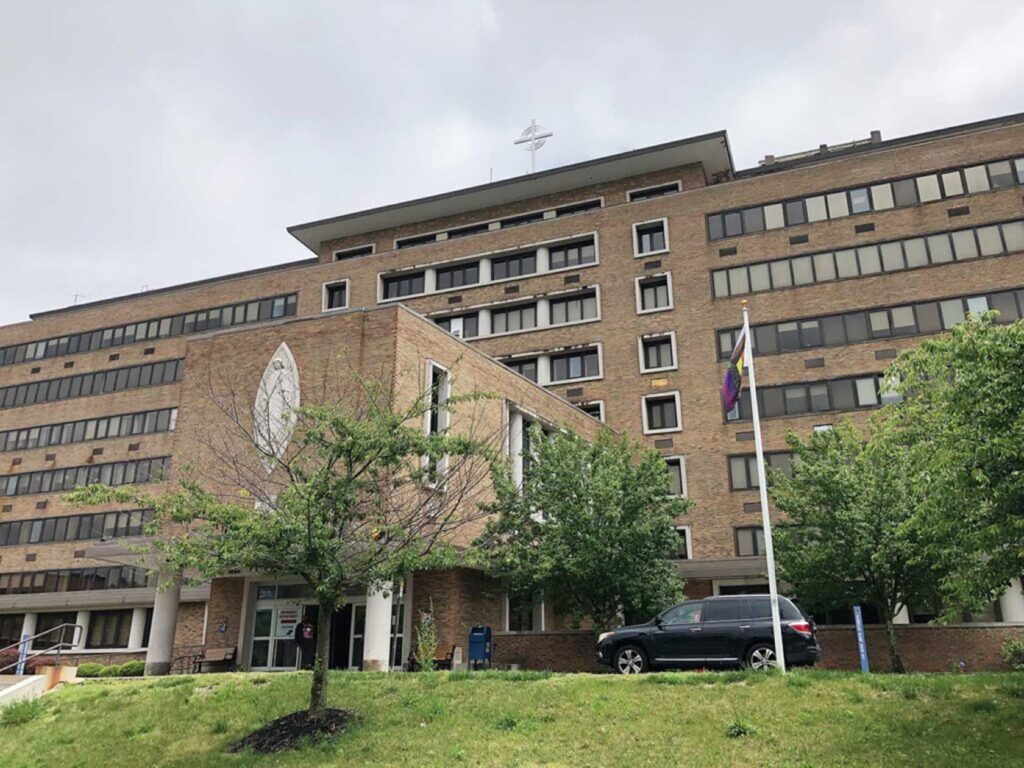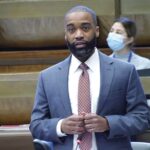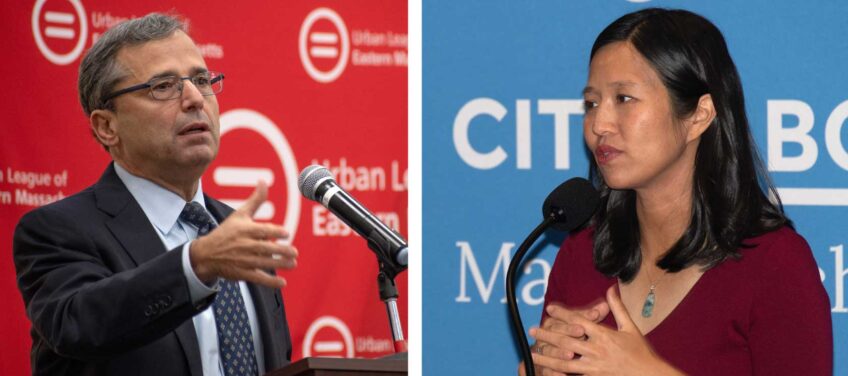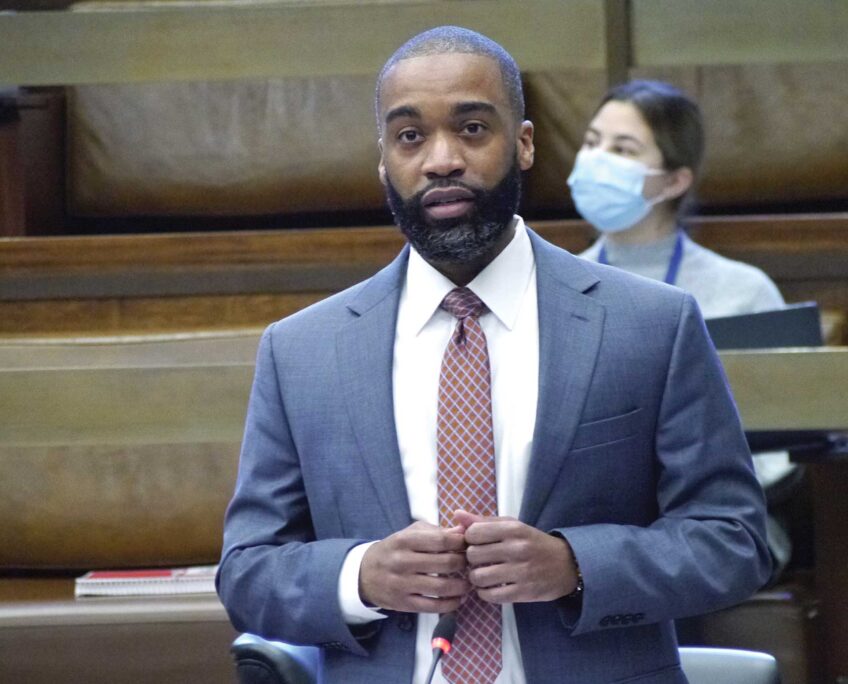What’s next for former Carney Hospital site?
Primary care, behavioral health, social needs centered in recommendations from working group

In the wake of the closure of Carney Hospital, behavioral health, access to emergency medical services and social elements that support health are among the key recommendations for how to best support health in the community the hospital previously served.
The recommendations come from a report released April 23, about eight months after the hospital shut its doors at the end of August, by a state-organized working group convened to identify gaps in care left by the closure.
For leadership of the working group, the closure, even with the challenges it presents, also offers an opportunity to close gaps that existed before Steward Health Care closed the hospital last summer, during bankruptcy proceedings and as Gov. Maura Healey worked to push the for-profit health care company out of the state.
“If we could envision the future for that campus, what would it look like?” said Bisola Ojikutu, the city’s public health commissioner, who co-chaired the working group.
The working group was formed by Gov. Maura Healey alongside a parallel one to address the same issues around the closure of Nashoba Valley Medical Center in Ayer at the end of September. Over nine meetings and six months, the working group talked to experts and local community voices to understand what needs existed. The work was also informed by thousands of conversations with residents in an effort from local nonprofit Health Care for All.
The current landscape, impacted by both the closure of Carney Hospital and previously existing gaps in access, were recorded in the 60-page report that offered six overarching recommendations and a host of proposed action steps, focused on access to emergency services, primary care and behavioral health; reuse of the Carney Hospital campus; and increased support for social determinants of health — factors like affordable housing, access to healthy food and economic mobility that impact the health of residents before they even step foot in a hospital.
Much of the work and the recommendations stemmed from the community’s feelings of disappointment and anger left by the closure of the hospital, said Michael Curry, president and CEO of the Massachusetts League of Community Health Centers, who co-chaired the group.
“It’s the hospital they either relied on or that their families have relied on for generations,” Curry said. “To have that loss weakens their access or diminishes their access to health within their neighborhoods, closer to home.”
What’s next for the shuttered hospital site?
Central to the discussion and recommendations is the question of what happens next on the nearly 13-acre site where the now-shuttered hospital stands. Since its doors were shut in August, most of the Carney Hospital facility has sat unused. The building, the report said, faces years of deferred maintenance.
On the smaller, one-acre parcel on the site, the Seton Medical Office Building has continued some operations, offering primary and some specialty care services.
The working group, in its report, recommended that the two parcels be facilitated to be reused for high-quality health care services and social services to meet community needs. That work, the report proposed, should maintain offerings previously provided by the hospital, like its emergency department, as well as include lab capacity and diagnostic imaging such as MRIs, mammography, ultrasounds, and X-rays.
The future of the site, the report proposed, should also continue to offer or include a replacement ambulance garage and radio infrastructure that is currently included at the Carney Hospital site.
The working group declined to take a stance on specifics around ownership structure or on the reuse of existing facilities versus the construction of new ones.
The report recommended that local authority be used to ensure site owners include health care offerings on the site — something Mayor Michelle Wu has said she intends to do.
In a letter last August to the property owners, Wu said she would use the city’s authority to oppose any attempt to rezone the land for uses other than health care.
Wu has also stepped in more recently, as the real estate trust that owns the parcel on which the Seton building stands sent notices to physician tenants in the building that their leases will be terminated on May 22.
According to the working group’s report, Wu issued a letter to the property owners demanding they reverse the decision.
Expanding health beyond clinical care
A major part of the report includes recommendations that whatever happens next with the site includes an expansion of what services can be offered there.
In the report, the working group said that case studies they reviewed showed that in other instances of hospital closures across the country, leveraging the land to address health-related social needs — the social determinants of health — can be an effective way to improve community health.
“We’re all aware that health outcomes — particularly big picture health outcomes, like life expectancy, like premature mortality — they don’t begin or end within the walls of healthcare facilities,” Ojikutu said. “Carney Hospital is not where health inequities in that neighborhood either began or it wasn’t necessarily solved by that hospital.”
Throughout the process, community members raised that desire for those expanded services, the report said.
“It became an opportunity to say, ‘Let’s reimagine this site, where it’s not just a provision of health care, but we’re now addressing that 80% of what drives your health status that has nothing to do with the care that’s provided to you,” Curry said, citing public health statistics that suggest that clinical care only makes up about 10% to 20% of an individual’s health.
In communication with residents, the working group found affordable housing, economic mobility, homelessness and housing insecurity, food access, community safety and access to care as key social determinants of health impacting their communities.
Throughout the working group’s process, a focus on social determinants of health and factors beyond just the medical care provided within the hospital has been a point of focus.
More broadly, addressing those big-picture outcomes has been a priority for the Boston Public Health Commission, which in July launched a health equity agenda called the Live Long and Well agenda to target gaps in life expectancy, especially focused on drug overdoses, cardiometabolic diseases and preventable cancers.
The report specifically referenced that effort — as well as the state Department of Public Health’s Advancing Health Equity in Massachusetts initiative, which is focused on maternal health disparities and social factors around cardiometabolic diseases — as steps to address health disparities in the community formerly served by Carney Hospital.
In the shorter term, pending decisions about how to use the site, the working group recommended improving outreach through services like the Health Commission’s Mayor’s Health Line; supporting increased transportation through services like the MBTA’s reduced-income RIDE program and the shuttle from the city’s Age Strong Commission; and supporting programs that push for things like increased food and housing access.
Closing gaps in behavioral and mental health
Another longstanding concern raised in the report is the loss of behavioral health care in the area. Before its closure, Carney hosted 50 in-patient behavioral health beds, which served patients across a wide range of ages and those with co-occurring mental health and substance use disorder needs.
The loss of those beds was highlighted as a point of concern by residents and other community members before the hospital shut its doors last summer.
“When you look at mental health needs in the city of Boston, and particularly in this neighborhood, and you think about the lack of access to care and the inequities that we know are present in access to behavioral health and mental health services, we know that this particular area surrounding Carney … were at a particular disadvantage in terms of their access,” Ojikutu said. “The fact that there are behavioral health beds that were lost from Carney, we see that as a major issue.”
It’s part of a broader challenge statewide, Curry said. Massachusetts faces an ongoing shortage of mental health professionals, according to a December 2024 report by the Massachusetts Taxpayers Foundation, and research has found that language and cultural barriers, as well as long wait times for MassHealth Patients, have contributed to these gaps for low-income patients of color.
“It’s not just about Carney Hospital, quite frankly. It’s about Massachusetts; it’s about Boston; it’s about Worcester; Springfield,” Curry said. “We need to explore and find ways to greatly increase access to mental health services along the whole spectrum of conditions.”
To address those gaps, the report proposes advocating expanded financial support for local community health centers and other programs, like the Boston Public Health Commission’s youth mental health initiative.
Many of those same organizations are centered in the report’s proposal to preserve and improve access to primary care services, something Curry said will make sure community members can get the right care at the right cost and at the right time.
Formerly, before Carney Hospital shut down, some of the patients seeking out care at the hospital’s emergency department would have been better served by primary care at a health center, he said.
“If we can address the access issues and make sure that health centers and others are available, have the resources, have the provision physicians they need, the nurses they need, the clinical support they need, they’re the best place to provide care to these populations,” Curry said.
Not smooth sailing on the horizon
The recommendations offer a vision for how the area can move forward, Ojikutu said, but aren’t unhampered by the reality and challenges of the current landscape for health care operations and for the funding of projects generally.
Part of the working group’s discussions included how to adjust and account for health care financing challenges, and ways to make sure the site, however it is used to improve health, can be profitable and sustain operations.
“We’ve clearly set forth recommendations, and that’s an important step, but paying for those interventions, paying for those services, is really the bigger issue,” Ojikutu said. “That’s what we need to figure out, and how we will move forward, particularly in this current fiscal environment.”
Within the next months, she said the working group will reconvene to address that question. In the meantime, it will continue to meet with stakeholders like the city and state, as well as Apollo Global Management, which owns the land through a subsidiary, to “map a feasible and sustainable way forward.”
The work, Ojikutu said, will require collaboration, but addressing those challenges is an important next step.
“What will we do to make sure that this happens, that these aren’t just recommendations that don’t go anywhere?” she asked.






